Special Interview_Like a painter of unique works, Dr. Matsubayashi explores the world of peptide hormones with unparalleled technological skills.
<Interviewee>
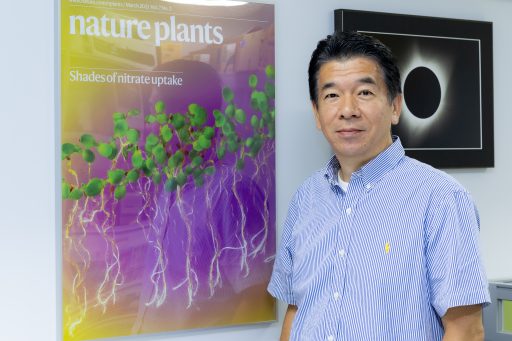
Yoshikatsu MATSUBAYASHI (Ph.D.)
Professor, Department of Biological Science, Graduate School of Science, Nagoya University
—
Dr. Matsubayashi made the world’s first discoveries of plant peptide hormones and their receptors in succession, with his findings being published in many renowned academic journals, including Science. He continues to lead the field of expertise with unique ideas and skills derived from his knowledge of both chemistry and biology.
—
● How do researchers develop their originality?
In 1996, Dr. Matsubayashi made the world’s first discovery of the plant peptide hormone PSK (phytosulfokine), one of the hormones essential for communication between cells. Before that discovery, a lot of attention in the research world had been paid to the existence of a mysterious substance that promoted cell proliferation. It was Dr. Matsubayashi who identified PSK as that substance. Furthermore, at that time, peptide hormones had been believed to exist just in animals, not in plants. Dr. Matsubayashi’s discovery was so novel that peer reviewers of his paper were skeptical about it. This achievement opened up a new path for him as a researcher. At least it seemed so, but Dr. Matsubayashi felt unsure.
He confesses, “Researchers of this type were likely to end up as one-hit wonders.”
The laboratory that Dr. Matsubayashi belonged to was a group of researchers known as “molecule hunter,” who identified active substances in natural products. Their usual move was to pick a phenomenon discovered by other biologists and identify the molecules involved in it. However, there was only a limited number of notable phenomena to pursue, and there was fierce competition in all of those research themes. It was not easy to be the first to discover an unknown hormone, but such tough circumstances did not discourage Dr. Matsubayashi. What should such researchers rely on when making their next move?
His answer to this question is: “I should look back on the path I have taken.”
PSK, the above-mentioned peptide hormone, is a small molecule consisting of five amino acids linked in this order: tyrosine-isoleucine-tyrosine-threonine-glutamine. As a point of information, large molecules with a large number of amino acids linked together are called “proteins,” while small molecules with a small number of amino acids linked together are called “peptides.” After examining all the conditions he could think of, including heat resistance, molecular size, and resistance to enzymatic digestion, Dr. Matsubayashi analyzed the peptide and succeeded in determining the amino acid sequence it contained.

Conceptual diagram of amino acids contained in the peptide hormone PSK
Things did not end there. Mass spectrometry showed that the sequence weighed 846, which was 160 more than five amino acids. This fact led to the discovery of the structure of the sequence: a sulfate group with a weight of 80 was attached to the first and third tyrosines.
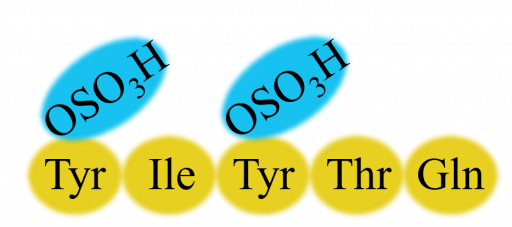
Conceptual diagram of the peptide hormone PSK with sulfate groups attached
After being translated from a gene into a molecule made up of amino acids, it needed further modification in order to function. Because peptide hormones are small, they can easily diffuse between cells, making it convenient for the cells to exchange information. On the other hand, with a limited number of amino acids, it is difficult to increase the variation of hormones. These molecular backgrounds are presumed to be one of the reasons why post-translational modifications such as sulfate groups are made, despite the use of energy.
“This is knowledge from organic chemistry,” Dr. Matsubayashi remarks. “It is the world of chemistry.”
Dr. Matsubayashi has always loved and studied both biology and chemistry, and has utilized their knowledge in his research. His skill in precisely determining chemical structures gave him a great advantage. Furthermore, he incorporated genetic analysis, which was cutting edge at the time, into his research. Dr. Matsubayashi talks about “the perfection of molecule hunter that I would aim for if there were such a thing.”
“That would be to search for hormones from the molecular side rather than relying on biologists’ papers. The culmination of my research is to use chemistry to explore phenomena that even biologists do not know about.”
This is the general process he follows. First, he reads genome information to find candidate genes that are likely to become hormones. After finding molecules that have been translated from genes and modified, he performs mass spectrometry to determine their structures. Finally, he synthesizes the molecules and investigates the biological phenomena they cause. Dr. Matsubayashi has established this process as his original research style. It is in the reverse order to the normal molecule hunter’s approach, which uses biological phenomena as a starting point.
“Ideas spread in an instant, but skills cannot be easily copied,” Dr. Matsubayashi explains. “Researchers need both ideas and skills, but I believe that skills are just as important, if not more so, than ideas.”
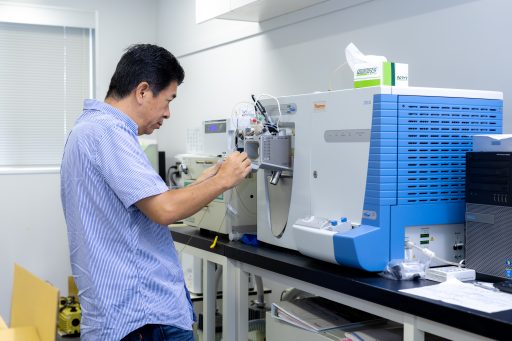
One of the mass spectrometers he regularly uses. By watching technicians who came for repairs, Dr. Matsubayashi learned how to do simple repairs.
● His discovery of a receptor defied the common wisdom in the world
If a hormone is compared to a ball, it needs a receptor, just as a ball needs a glove.
“Looking back, I think I did a great job,” Dr. Matsubayashi recollects. “After the discovery, I started to get recognized little by little.”
At the time, the world was still skeptical about recognizing PSK as a hormone. In fact, Science passed to publish his paper on PSK at the time. The tide changed, however, in 2002, when the team of Dr. Matsubayashi discovered the receptor for PSK. He skillfully manipulated PSK to purify a PSK-binding protein, from which he derived genetic information, and he confirmed that it contained information on sites commonly found in receptors. Dr. Matsubayashi also confirmed that excessive production of this protein promoted cell proliferation. The protein proved to be the receptor for PSK. The results of this study were published in Science, and Dr. Matsubayashi was brilliantly vindicated six years after the discovery of PSK.
The skills they developed in this finding were important for subsequent research. Hormones and receptors exist in pairs. If one side of a pair is identified, that is a powerful clue to finding the other side of the pair. It is also possible to tell when and where certain cells communicate, and this knowledge is useful for elucidating specific mechanisms. For example, it was predicted at the time that two molecules, CLV1 and CLV3 (clavata 1 and 3), were involved as hormones and receptors in the continued production of the cells from which stem tips derive their leaves and flowers. However, no one had been able to prove it. Dr. Matsubayashi’s research group investigated the structures of these two molecules and found that CLV3 is a peptide hormone and that CLV1 is a receptor, and they bind directly. His group had unparalleled momentum that no other research group could match.
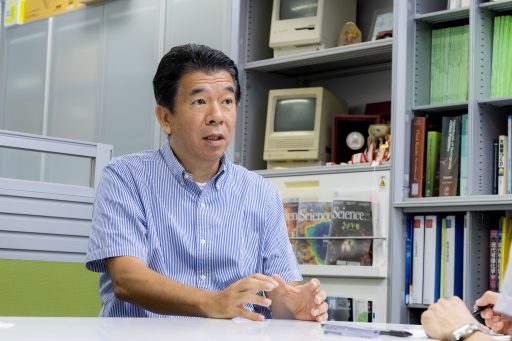
● “Science is art”: Using unique skills, Dr. Matsubayashi pursued the mystery of the peptide hormone PSY for 15 years
Of course, not all of his research projects went smoothly. One of his uphill struggles was research on the new peptide hormone PSY (plant peptide containing sulfated tyrosine). Based on the characteristics including the post-translational modification of sulfate groups, Dr. Matsubayashi made the discovery of PSY and published it in 2007. He found that PSY promotes root growth and cell proliferation, and that it has a role similar to that of PSK, the first peptide hormone he discovered. However, elucidation of PSY’s specific function did not go as smoothly as expected. After a 15-year struggle, he finally got the whole picture in 2022.
“I was uneasy about whether it was really a hormone,” Dr. Matsubayashi recalls. “But at the same time, I was confident. Although the function was still unknown, there was post-translational modification, and the receptor had been identified. These facts had helped me stay motivated for 15 years.”
When a hormone binds to its receptor, a certain function is turned on. According to this idea, for example, when the peptide hormone PSY binds to its receptor, root growth must be promoted. In fact, Arabidopsis plants that cannot properly produce PSY have shorter roots. In order to confirm the hypothesis, Dr. Matsubayashi added artificially synthesized PSY to them, and the roots grew long.
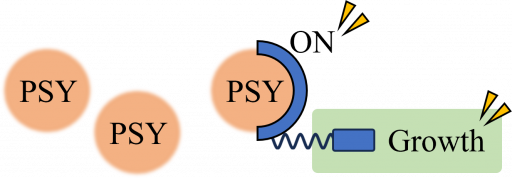
Conceptual diagram of PSY binding to its receptor. In this case, the roots grow long.
So, what happens in the case of Arabidopsis plants that have PSY but lack a receptor? The PSY has no receptor to bind to, so here again, there is no PSY-receptor pair. Despite this, the Arabidopsis plants that lacked the receptor grew roots steadily.

Conceptual diagram of receptor deficiency. In this case, the roots grow long.
Is there any unknown receptor that PSY binds to? Or does PSY have another function? Then, Dr. Matsubayashi created Arabidopsis that could not produce PSY or its receptor. Again, the roots grew longer than expected. This indicated that he was missing something about the receptor. As a matter of fact, the receptor had the ability to put a “brake” on growth when it was not bound to PSY. When bound by PSY, the receptor releases the brake, allowing growth. Accordingly, when the receptor is missing, so is the brake, and in this case too, the roots grow long.

Conceptual diagram of switching based on PSY-receptor binding. When the receptor is not bound by PSY, it puts a brake on growth, and, as described below, the cells prioritize stress responses.
Further genetic analysis revealed that when growth is put on hold by the receptor, energy is preferentially spent to deal with stresses, such as high salt concentration, high temperature, or disease. Under normal conditions, individual cells constantly release PSY, which binds to the receptor in other cells, causing the plant to keep growing. In contrast, when a cell breaks down, the cells around it undergo a decrease in PSY concentration. Then, the receptor in these surrounding cells is unable to be bound by PSY, preparing for stress responses rather than growth. In other words, there proved to be a mechanism to detect that something strange had happened in the event of a loss of “regular reports” between cells.
Plants have steadily evolved to adapt to various environmental changes, but such a sophisticated mechanism is beyond our imagination. In this way, the research group led by Dr. Matsubayashi uncovered another plant mechanism that could almost be called artistic, as a result of the constant ambitious efforts they had made while believing in the skills they had built up by themselves.
Dr. Matsubayashi’s research group has a variety of unique skills, including the precise determination of molecular structures based on chemical knowledge, genetic analysis, and the search for candidate molecules that are pairs of peptide hormones and receptors. Mainly through research with members of his own group, Dr. Matsubayashi pursues what he is eager to know.
“To me, science is art, not business,” he argues. “If I compare my team to a group of painters, we do not divide our work too finely, like assigning the sketching to painter A and the coloring to painter B. Each person works on what they want to depict, and they want to see it through to the end. We want to write an academic paper that we would want to frame and display. If our papers were displayed anonymously, they would probably be recognizable as ours.”
(Interview and text by Tatsuro Ayatsuka)
